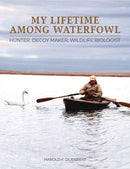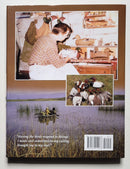Description
Hardcover, 228 Pages.
Waterfowl hunting in North American experienced two great eras. The first occurred in the last three decades of the 19th century when autumn skies were filled with waterfowl and hunters had access to remote areas such as the northern prairies via rail cars. Harold Duebbert recounted this first era in his 2003 book, Wildfowling in Dakota: 1873-1903. By the early 20th century, waterfowl populations were declining and the 1930s "Dust Bowl" drought brought further drastic declines in duck populations across the Prairie Pothole Region that constituted 10 percent of the waterfowl breeding habitat but produced 50 percent of the continent's migratory ducks in average years. When water returned to the prairies at the end of the 1930s, prairie nesting duck populations rebounded dramatically, initiating a second great era of duck hunting just as Harold was beginning his life as a waterfowl hunter in 1940. Harold lived this second great era of waterfowl hunting as a hunter, decoy maker and wildlife biologist, and he documented it in his 56 years of hunting journals. Now readers may re-live it as he takes them back to those bygone years in My Lifetime Among Waterfowl.
Review By Jim Casada:
Far softer in tone, a sort of sit down, kick off your shoes and relax in your recliner kind of volume is Harold E. Duebbert’s My Lifetime Among Waterfowl. This is a sumptuous volume “done right” while featuring attractive binding, a fetching dust jacket and in a coffee table size format. Yet this work, while amply illustrated with scores of color images, is anything but a work to be placed in a prominent place in a den or gun room simply for its aesthetic appeal. Rather, it chronicles, in nicely crafted prose and the sort of personal attachment that goes a long way in making a book enjoyable to read, more than a half century of a hunter-biologist’s life in the world of waterfowl.
The author was ideally placed to write such a book in a number of ways. He had previous experience as an author in this specific area of coverage with his Wildfowling in Dakota, 1873-2003, and his passion for all aspects of waterfowling reverberates from every page. Duebbert meticulously maintained hunting journals for 56 years, and those journals furnished the backbone for this work. He loved to hunt, and in a sense his involvement with decoy making was an extension of his passion for whistling wings at dawn with a chill wind blowing across the prairies and bevies of birds filling a leaden sky of scudding clouds. Overlaying everything was his profession—that of a trained and devoted wildlife biologist.
In this memoir, published posthumously, we are given a splendid reminder of the roles of those who have long been in the conservation trenches have played, and for my part I’ll take one man like Harold Duebbert over a hundred of the so-called wildlife biologists who have never hunted and, if stripped to the bare bones of truth, don’t even like hunting. Waterfowling was his life, and here’s a man who appreciated the complex interaction of sport, resources protection and the power of passion for what one does. It’s a might fortunate soul who can blend his work with his pursuits of passion while, in doing so making the world a bit better place. Harold Duebbert was clearly such a man, and when you learn that his ashes were spread across one of his favorite marshes in North Dakota it is easy to state, with conviction, “this is a man I wish I could have known.” Short of having been so privileged, this delightful book is the next best option.—Jim Casada
Payment & Security
Your payment information is processed securely. We do not store credit card details nor have access to your credit card information.






























